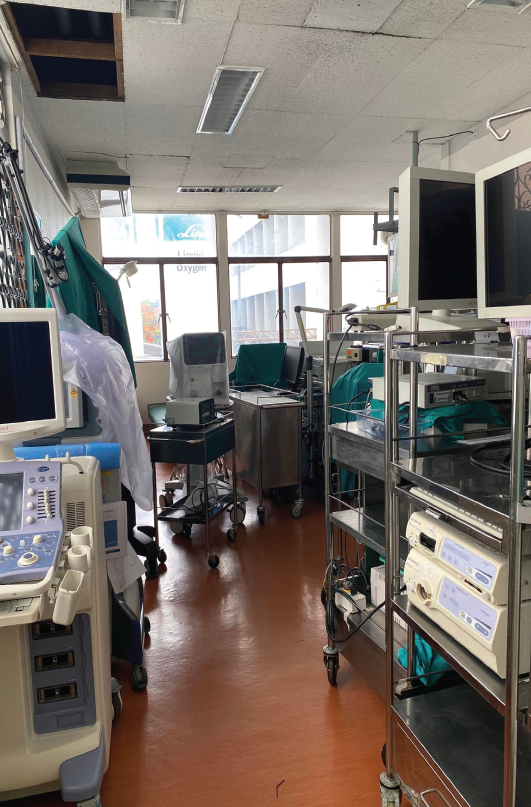Physical factors affecting stress of healthcare operators in operating room
Main Article Content
Abstract
This research examines the stress factors caused by the physical environment in the operating room of medical personnel work. Guidelines for designing and managing an operating room environment to reduce stress and increase the efficiency of operating room healthcare workers. Using surveys and interviews, the content is divided into 3 parts; (1) an introduction to environmental stress (2) factors causing stress from the physical environment and (3) a survey and interview to analyze the causes of stress caused by the physical environment both design internal environment and current building management. The results can summarize the risk factors that cause stress and reduce the performance of medical personnel in the operating room into 4 factors; (1) ambient features, (2) architectural features, (3) interior design features and (4) external outdoor environment features also found that the behavior of the operating room medical personnel is a major contributor to the workplace environment. The environment inside the operating room is not conducive to use. These results lead to physical factors affecting stress reduction in operating room healthcare workers and further design of a suitable working environment for the medical staff in the operating room.
Article Details

This work is licensed under a Creative Commons Attribution-NonCommercial-NoDerivatives 4.0 International License.
References
Aiken L., Clarke S. & Sochalski J. (2001). An international perspective on hospital nurses’ work environments: the case for reform. Policy, Politics & Nursing Practice, 2, 255-263.
Association of perioperative registered nurses. (2017). Guidelines for perioperative practice. Denver: AORN, Inc.
Chida, Y. & Hamer, M. (2008). Chronic psychosocial factors and acute physiological responses to laboratory-induced stress in healthy populations: a quantitative review of 30 years of investigations. Psychological Bulletin, 134(6), 829–885.
Felsten, G. (2009). Where to take a study break on the college campus: an attention restoration theory perspective. Journal of Environmental Psychology, 29(1), 160-167.
Gilby, A., Blyth, A. & Barlex, M. J. (2006). Guide to post occupancy evaluation. London: Higher Education Funding Council for England / Association of University Directors of Estates.
Hartig, T., et al. (2014). Nature and health. Annual Review of Public Health, 35(1), 207–228.
Medical Engineering Division. (2010). Mattrathan hong phatat. (In Thai) [Operating room standard]. Bangkok: Department of Health Service Support.
Ofei, A.M.A., et al. (2018). Stress and coping strategies among nurse managers. Journal of Nursing Education and Practice, 2(1), 1-13.
Opastiragul, W., Chanprasit, C. & Kaewthummanukul, T. (2015). Phawa sukkhaphap tam khwam siang chak karn tham ngan khong phayabaan wichachip ngankarn phayabaan, phupuai nok lae phupuai chukchoen, rongphayabarn Maharaj Nakhon Chiang Mai. (In Thai) [Health status related to risk at work among professional nurses, out patient and emergency nursing section, Maharaj Nakorn Chiang Mai hospital]. Nursing Journal, 42(2), 49-57.
Preiser, W.F.E., Rabinowitz, H.Z., & White, E.T. (1988). Post-occupancy evaluation. New York: Van Nostrand Reinhold.
The Center for Health Design. (2011). Clinic design post-occupancy evaluation toolkit. Retrieved January 15, 2021, from https://www.healthdesign.org/insights-solutions/clinic-design-post-occupancy-evaluation-toolkit-pdf-version
Ulrich, R. (1986). View through a window may influence recovery from surgery. Science, 224(1), 420–421.
Ulrich, R. (2000). Evidence based environmental design for improving medical outcomes. Journal of Social Issues, 35, 156-184.
Waroonkun, T. (2020). Thatsanakhati khong phupuai tor laksana khong hong truat sukkhaphap nai rongphayabarn Thai. (In Thai) [Patient attitudes to features of a medical examination room in a Thai hospital]. The International Journal of Design Management and Professional Practice, 14 (3), 29-45.
Winkel, G.H., & Holahan, C.J. (1986). The environmental psychology of the hospital: is the cure worse than the illness. Prevention in Human Services, 4, 11–33.
Wutthikhosit, U. (2007). Karn okbaep rongphayabarn. (In Thai) [General hospital design]. Bangkok: Faculty of Architecture, Chulalongkorn University.


